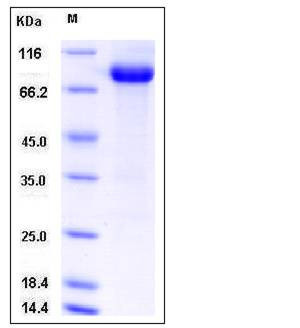Mouse DDR1 Kinase / MCK10 / CD167 Protein (Fc Tag)
6030432F18,AI323681,Cak,CD167a,Nep,PTK3A
- 100ug (NPP3287) Please inquiry
| Catalog Number | P50829-M02H |
|---|---|
| Organism Species | Mouse |
| Host | Human Cells |
| Synonyms | 6030432F18,AI323681,Cak,CD167a,Nep,PTK3A |
| Molecular Weight | The secreted recombinant mouse DDR1/Fc is a disulfide-linked homodimer. The reduced monomer comprises 636 amino acids and has a calculated molecular mass of 71 kDa. As a result of glycosylation, the apparent molecular mass of rmDDR1/Fc monomer is approximately 80-90 kDa in SDS-PAGE under reducing conditions. |
| predicted N | Asp 20 |
| SDS-PAGE |  |
| Purity | > 95 % as determined by SDS-PAGE |
| Protein Construction | A DNA sequence encoding the extracellular domain of mouse DDR1 (NP_766550.1) (Met 1-Thr 414) was fused with the Fc region of human IgG1 at the C-terminus |
| Bio-activity | |
| Research Area | Developmental Biology |Embryogenesis |Germ Layer Formation |Ectoderm Marker |
| Formulation | Lyophilized from sterile PBS, pH 7.4 1. Normally 5 % - 8 % trehalose and mannitol are added as protectants before lyophilization. Specific concentrations are included in the hardcopy of COA. |
| Background | Discoidin domain receptor family, member 1 (DDR1), also known as or CD167a (cluster of differentiation 167a), and Mammary carcinoma kinase 10 (MCK10), belongs to a subfamily of tyrosine kinase receptors with an extracellular domain homologous to Dictyostellium discoideum protein discoidin 1. Receptor tyrosine kinases play a key role in the communication of cells with their microenvironment. These kinases are involved in the regulation of cell growth, differentiation and metabolism. Expression of DDR1/MCK10/CD167 is restricted to epithelial cells, particularly in the kidney, lung, gastrointestinal tract, and brain. In addition, it has been shown to be significantly overexpressed in several human tumors. DDR1/MCK10/CD167 plays an important role in regulating attachment to collagen, chemotaxis, proliferation, and MMP production in smooth muscle cells. DDR1 functions in a feedforward loop to increase p53 levels and at least some of its effectors. Inhibition of DDR1 function resulted in strikingly increased apoptosis of wild-type p53-containing cells in response to genotoxic stress through a caspase-dependent pathway. |
| Reference |
